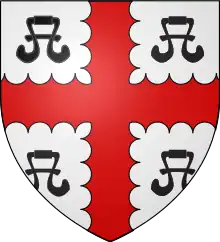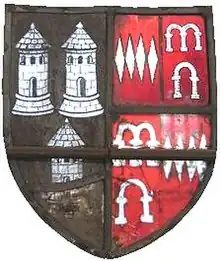Fulk Bourchier, 10 Baron FitzWarin | |
|---|---|
 Arms of Bourchier: Argent, a cross engrailed gules between four water bougets sable[1] | |
| Born | 25 October 1445 |
| Died | 18 September 1479 (aged 33) |
| Noble family | Bourchier |
| Spouse(s) | Elizabeth Dynham |
| Issue | John Bourchier, 1st Earl of Bath Elizabeth Bourchier Joan Bourchier |
| Father | William Bourchier, 9th Baron FitzWarin |
| Mother | Thomasine Hankford |
Fulk Bourchier, 10th Baron FitzWarin (25 October 1445 – 18 September 1479)[2] was the son and heir of William Bourchier, 9th Baron FitzWarin (1407–1470) and the father of John Bourchier, 1st Earl of Bath. He was feudal baron of Bampton in Devon.
Origins
Fulk Bourchier was the eldest son and heir of William Bourchier, 9th Baron FitzWarin (1407–1470) by his wife Thomasine Hankford, a daughter and coheiress of Sir Richard Hankford (c. 1397 – 1431) of Annery, Devon, feudal baron of Bampton.[3]
Marriage and issue


Fulk Bourchier married Elizabeth Dynham (died 19 October 1516),[5] the daughter of Sir John Dinham (1406–1458) of Nutwell by his wife Joan Arches (died 1497), and sister and coheir of John Dynham, 1st Baron Dynham (died 1501). After the death of Fulk Bourchier, Elizabeth Dynham remarried twice, firstly to Sir John Sapcotes (died 1501) of Elton, Huntingdonshire; a stained glass heraldic escutcheon survives in Bampton church showing the arms of Sapcotes impaling Dinham. After the death of Sapcotes, Elizabeth Dynham remarried secondly to Sir Thomas Brandon (died 27 January 1510) of Duddington, Northamptonshire.[6] There was no issue of Elizabeth Dynham's marriage to Thomas Brandon, and according to Gunn, after his death she took a vow of celibacy before Bishop Fisher on 21 April 1510.[7] She died 19 October 1516, and was buried in the Greyfriars, London.[8][9]
By Elizabeth Dynham, Fulk Bourchier had the following children:
- John Bourchier, 1st Earl of Bath (20 July 1470 – 30 April 1539)[10]
- Joan Bourchier (died 3 March 1532), second wife of James Tuchet, 7th Baron Audley, who was beheaded 28 June 1497 on Tower Hill for his part in the Cornish rebellion, and buried at the Blackfriars, London.[11]
- Elizabeth Bourchier (before 1473 – 8 August 1557)[12] who married, as his second wife, Sir Edward Stanhope (1462 – 6 June 1511), by whom she was the mother of Anne Stanhope (c. 1497 – 1587),[13] the second wife of Edward Seymour, 1st Duke of Somerset (c. 1500 – 1552), brother of Queen Jane Seymour, uncle of King Edward VI and Lord Protector of England. The Duchess's monument and effigy survives in Westminster Abbey and displays profusely the Bourchier arms and Bourchier knots.
Death and burial
Bourchier died 18 September 1479 at the age of thirty-three. In his will, dated 1 April 1475 and proved 10 November 1480, he requested burial in the chapel of the Blessed Virgin at Bampton, Devon, next to the tomb of his mother, the Lady Thomasine. He left the residue of his estate to his wife, Elizabeth Dynham, whom he made his sole executrix.[14]
Dugdale, quoting the will of Fulk Bourchier, shows that his father, William Bourchier, and his mother, Thomasine Hankford, are also buried at Bampton, as he bequeathed his body to be buried at Bampton near the grave of his mother, Lady Thomasine, and he willed that marble stones with inscriptions should be placed on his own grave and that of his father, Lord William, and his mother, Lady Thomasine.[15][16]
Notes
- ↑ Dallas gives the arms of William Bourchier, his son Fulk and grandson John as 'Argent, a cross engrailed gules between four water-bougets sable, a label of three points azure each charged with as many fleurs-de-lys or'; Dallas 1897, pp. 107–8, 110.
- ↑ Cokayne 1926, pp. 508–9.
- ↑ Burke 1831, p. 73; Richardson I 2011, p. 282.
- ↑ Also the arms of the ancient family of Shapcott of Shapcott in the parish of Knowstone, Devon, sometimes shown with a chevron or between the dovecotes (Vivian, p.677, pedigree of Shapcott of Shapcott)
- ↑ Cokayne 1926, p. 510.
- ↑ Cokayne 1926, pp. 509–510; Richardson I 2011, p. 87; Gunn 2004.
- ↑ Gunn 2004.
- ↑ Cokayne 1926, p. 510.
- ↑ Gunn states that she was buried in the priory of St Mary Overie, Southwark.
- ↑ Burke 1831, p. 73.
- ↑ Burke 1831, p. 73; Cokayne 1926, p. 342; Arthurson 2004.
- ↑ Nichols 1857, p. xxxi; Warnicke 2004.
- ↑ Burke 1831, p. 73.
- ↑ Cokayne 1926, p. 510.
- ↑ Stabb, John, Some Old Devon Churches, pp. 13-24 Retrieved 5 April 2013.
- ↑ Rogers 1877, pp. 84–6.
References
- Arthurson, Ian (2004). "Tuchet, James, seventh Baron Audley (c.1463–1497)". Oxford Dictionary of National Biography (online ed.). Oxford University Press. doi:10.1093/ref:odnb/27576. (Subscription or UK public library membership required.)
- Burke, John (1831). A General and Heraldic Dictionary of the Peerages of England, Ireland and Scotland, Extinct, Dormant and in Abeyance. London: Henry Colburn and Richard Bentley. p. 73. Retrieved 5 April 2013.
sir richard page.
- Cokayne, George Edward (1926). The Complete Peerage, edited by Vicary Gibbs and H.A. Doubleday. Vol. V. London: St Catherine Press. pp. 508–11.
- Dallas, James and Henry Porter (1897). The Notebook of Tristram Risdon. London: Elliot Stock. pp. 107–8, 110. Retrieved 5 April 2013.
- Gunn, S.J. (2004). "Brandon, Sir Thomas (d. 1510)". Oxford Dictionary of National Biography (online ed.). Oxford University Press. doi:10.1093/ref:odnb/3268. (Subscription or UK public library membership required.)
- Nichols, John Gough, ed. (1857). Literary Remains of King Edward the Sixth. Vol. I. London: J.B. Nichols and Sons. pp. xxx–xxxi. Retrieved 4 April 2013.
- Richardson, Douglas (2011). Everingham, Kimball G. (ed.). Magna Carta Ancestry: A Study in Colonial and Medieval Families. Vol. I (2nd ed.). Salt Lake City. p. 282. ISBN 978-1449966379.
{{cite book}}: CS1 maint: location missing publisher (link) - Rogers, W.H. Hamilton (1877). The Antient Sepulchral Effigies and Monumental and Memorial Sculpture of Devon. Exeter: William Pollard. pp. 84–6. Retrieved 5 April 2013.
- Warnicke, Retha M. (2004). "Seymour, Anne, duchess of Somerset (c.1510–1587)". Oxford Dictionary of National Biography (online ed.). Oxford University Press. doi:10.1093/ref:odnb/68053. (Subscription or UK public library membership required.)
External links
- Will of Fulk Bourchier, proved 10 November 1480, National Archives Retrieved 5 April 2013
- Will of Sir Thomas Brandon, proved 11 May 1510, National Archives Retrieved 5 April 2013